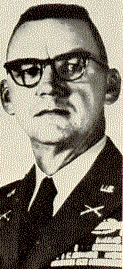
Oran Henderson was born in Indianapolis on Aug. 25, 1920. , he had spent much of his adulthood in combat. He served and was wounded in three wars -- World War II, Korea and Vietnam. He was awarded the Purple Heart four times for combat wounds, the Silver Star five times and the Bronze Star five times for valor."
By 1968, at the time of the My Lai incident, Colonel Henderson had been in the army for over 25 years and had his eye set on becoming a general. Prior to being put in charge of the 11th Battalion, Henderson had served in World War II and Korea, and had been awarded the Purple Heart four times.
My Lai was Henderson's first actual combat operation during the Vietnam War. He commanded four infantry battalions and 3,500 men. Despite his long service in the Army, Henderson had not been an automatic choice for the position. General Koster, who made the decision, testified, ”I knew him to be a brave individual and I thought a fairly strong leader. I wasn’t sure that he was necessarily the most intelligent of the people I had commanding the brigades.”
Other recollections about Henderson were only slightly more complimentary. He was “formal and crisp” with his staff. He had a commanding presence and rarely smiled. Some of his subordinates testified that they were “scared to death of Henderson.” One captain recalled, “He’s got to be the hardest man I’ve worked for.” He was harshly criticized by his troops for using the headquarter's entire allotment of air conditioning for his mess hall and personal quarters.
My Lai was supposedly where the 48th VC Battalion had its headquarters. Early in the day before the attack, Henderson had gathered his officers together for a pep talk. “When we get through with that 48th battalion they won’t be giving us any more trouble. We’re going to do them in once and for all.” Henderson also encouraged his men to be more aggressive, as he believed that the large discrepancies between body counts reported and weapons recovered numbers was due to the fact that as the enemy retreated, they took the weapons off the dead VC before the Americans could get to the bodies. So if his men would be more aggressive, the weapons recovered would be more proportional to the body counts. (Captain Medina gathered the men of Charlie Company together later that evening for a second pep talk.)
It is generally believed that while the incident at My Lai was going on, Henderson was in a Charlie Company command and control helicopter over the area. Henderson claimed in his testimony, however, that while over My Lai, he only saw six or eight bodies, although others who were in the same helicopter claimed to have seen thirty to forty. Henderson was back at his headquarters by 9:00 the morning of the incident, and so was aware that despite the high body counts that were coming over the radios, there were none of the usual sounds of a battle coming over the radios. Some who were at headquarters that day testified that Henderson and Lt. Colonel Barker had several private conversations that day, and several heated conversations in the days that followed, regarding the incident.
It is unclear exactly where the order came from, but Henderson seems to have been ordered to do an investigation of the My Lai incident. About 3:00 the day of the incident, Henderson ordered Medina to go back to My Lai to investigate exactly how many civilians had been killed.This order, however, was countermanded from higher up in the chain of command. Henderson, eager to please his superiors, may have interpreted this as an indication that a thorough investigation of the incident was not wanted. His investigation consisted of gathering his troops together and in a group asking if anyone had been involved in any indiscriminate killing. Henderson reported that all responded, “no, sir”. However, many who were there testified that they responded, “no comment.” On March 19, Henderson reported to General Young that his investigation was complete and that there had been no indiscriminate killing of civilians, women, and children at the Village of My Lai. There was testimony that Henderson had written several reports about the incident at My Lai in the following months. By the time of the Peers investigation, all had disappeared except one, and memories were exceedingly hazy.
In his testimony, Henderson denied ever being told anything about his troops wantonly killing large groups of civilians, although Thompson testified that he had spent twenty to thirty minutes describing in detail what he had seen occur. Other parts of Henderson’s testimony were simply described as “incredible.”
On February 26, 1971 the Army announced that Henderson would be tried by a general court martial for his role in the cover- up of My Lai. In the end, Henderson was the only officer who stood trial of the fourteen who were originally charged with participation in the cover-up. On December 17, 1971, he was found not guilty.
Henderson died of pancreatic cancer in 1998.
